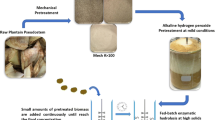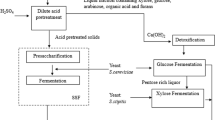Abstract
In this study, energy consumption for two stages of comminution of M. sacchariflorus and fermentable sugar production by hydrothermal pretreatment and enzymatic hydrolysis are investigated. Biomass comminution is carried out in two stages, which are chopping (18, 40, 80, and 160 mm length) and grinding using three screen sizes (3, 5, and 7 mm). In the chopping process, the highest total specific net energy efficiency is 17.35 kJ/kg when the biomass is chopped to 18 mm length. In the grinding process with chopped biomass, the total specific net energy efficiency ranges from 18.49 to 38.38 kJ/kg. In summary, the highest total specific net energy efficiency during the two stages of comminution is 44.58 kJ/kg when the biomass is chopped to 80 mm length and is sequentially ground to pass a screen size of 3 mm. The total fermentable sugar production ranges from 64.76 to 76.27 g/L, which is obtained from hydrolysate and enzymatic hydrolysis, depending on the biomass particle size. The highest fermentable sugar production is 76.27 g/L when hydrothermal pretreatment and enzymatic hydrolysis is performed with the ground biomass (chopping to 18 mm and sequentially ground to pass 3 mm screen). Considering the total fermentable sugar production and the total specific net energy efficiency, 18 mm length and less than 7-mm screen size is considered suitable for the chopping and the grinding, respectively, for the comminution of M. sacchariflorus.







Similar content being viewed by others
References
Ge Y, Li L (2018) System-level energy consumption modeling and optimization for cellulosic biofuel production. Appl Energy 226:935–945. https://doi.org/10.1016/j.apenergy.2018.06.020
Kundu C, Lee HJ, Lee JW (2015) Enhanced bioethanol production from yellow poplar by deacetylation and oxalic acid pretreatment without detoxification. Bioresour Technol 178:28–35. https://doi.org/10.1016/j.biortech.2014.08.082
Wang L, Barta-Rajnai E, Skreiberg Ø, Khalil R, Czeégény Z, Jakab E, Barta Z, Grønli M (2018) Effect of torrefaction on physicochemical characteristics and grindability of stem wood, stump and bark. Appl Energy 227:137–148. https://doi.org/10.1016/j.apenergy.2017.07.024
Bach QV, Skreiberg Ø (2016) Upgrading biomass fuels via wet torrefaction: a review and comparison with dry torrefacton. Renew Sust Energ Rev 54:665–677. https://doi.org/10.1016/j.rser.2015.10.014
Lynd LR (1996) Overview and evaluation of fuel ethanol from cellulosic biomass: technology, economics, the environment, and policy. Annu Rev Energy Enivron 21:403–465. https://doi.org/10.1146/annurev.energy.21.1.403
Yang B, Wyman CE (2008) Pretreatment: the key to unlocking low-cost cellulosic ethanol. Biofuels Bioprod Biorefin 2:26–40. https://doi.org/10.1002/bbb.49
Liu ZH, Qin L, Pang F, Jin MJ, Li BZ, Kang Y, Dale BE, Yuan YJ (2013) Effects of biomass particle size on steam explosion pretreatment performance for improving the enzyme digestibility of corn stover. Ind Crop Prod 44:176–184. https://doi.org/10.1016/j.indcrop.2012.11.009
Dasari RK, Eric Berson R (2007) The effect of particle size on hydrolysis reaction rates and rheological properties in cellulosic slurries. Appl Biochem Biotechnol 137:289–299. https://doi.org/10.1007/s12010-007-9059-x
Wang Z, Qin M, Fu Y, Yuan M, Chen Y, Tian M (2013) Response of chemical profile and enzymatic digestibility to size reduction of woody biomass. Ind Crop Prod 50:510–516. https://doi.org/10.1016/j.indcrop.2013.08.025
Miao Z, Grift TE, Hansen AC, Ting KC (2011) Energy requirement for comminution of biomass in relation to particle physical properties. Ind Crop Prod 33:504–513. https://doi.org/10.1016/j.indcrop.2010.12.016
Sokhansanj S, Kumar A, Turhollow AF (2006) Development and implementation of integrated biomass supply analysis and logistics model (IBSAL). Biomass Bioenergy 30:838–847. https://doi.org/10.1016/j.biombioe.2006.04.004
Hess JR, Wright CT, Kenney KL (2007) Cellulosic biomass feedstocks and logistics for ethanol production. Biofuels Bioprod Biorefin 1:181–190. https://doi.org/10.1002/bbb.26
Mani S, Tabil LG, Sokhansanj S (2004) Grinding performance and physical properties of wheat and barley straws, corn stover and switchgrass. Biomass Bioenergy 27:339–352. https://doi.org/10.1016/j.biombioe.2004.03.007
Kang SH, Lee HW, Hong DH, Lee DH (2013) Research about an integrated preprocessing system for Korean Giant Miscanthus in field. Korean Soc Agri Mach 18:285–286
Lee HW, Lee JW, Gong SH, Song YS (2018) Study on size reduction characteristics of Miscanthus sacchariflorus via image processing. J Korean Wood Sci Technol 46:309–314. https://doi.org/10.5658/WOOD.2018.46.4.309
Gong SH, Im HS, Um M, Lee HW, Lee JW (2019) Enhancement of waste biomass fuel properties by sequential leaching and wet torrefaction. Fuel 239:693–700. https://doi.org/10.1016/j.fuel.2018.11.069
Jeong SY, Lee JW (2016) Sequential Fenton oxidation and hydrothermal treatment to improve the effect of pretreatment and enzymatic hydrolysis on mixed hardwood. Bioresour Technol 200:121–127. https://doi.org/10.1016/j.biortech.2015.10.015
Sluiter A, Hames B, Ruiz R, Scarlate C, Sluiter J, Templeton D, Crocker D (2011) Determination of structural carbohydrates and lignin in biomass. Laboratory analytical procedure no. TP-510-42618. NREL, Golden
Liu Y, Wang J, Wolcott MP (2016) Assessing the specific energy consumption and physical properties of comminuted Douglas-fir chips for bioconversion. Ind Crop Prod 84:394–400. https://doi.org/10.1016/j.indcrop.2016.08.054
Khullar E, Dien BS, Rausch KD, Tumbleson ME, Singh V (2013) Effect of particle size on enzymatic hydrolysis of pretreated Miscanthus. Ind Crop Prod 44:11–17. https://doi.org/10.1016/j.indcrop.2012.10.015
Chaloupkova V, Ivanova R, Havrland B (2016) Sieve analysis of biomass: accurate method for determination of particle size distribution. Engineering for Rural Development 25:1012–1017
Vidal BC Jr, Dein BS, Ting KC, Sing V (2011) Influence of feedstock particle size on lignocellulosic conversion- a review. Appl Biochem Biotechnol 164:1405–1421. https://doi.org/10.1007/s12010-011-9221-3
Del Rio LF, Chandra RP, Saddler JN (2011) Fiber size does not appear to influence the ease of enzymatic hydrolysis of organosolv pretreatment softwoods. Bioresour Tehcnol 107:235–242. https://doi.org/10.1016/j.biortech.2011.12.057
Michael I, Ely M (2011) Effect of cellulose structure on enzymatic hydrolysis. Bioresources 6:2818–2835. https://doi.org/10.15376/biores.6.3.2818_2835
Funding
This research supported by the National Institute of Crop Science, Rural Development Administration, Korea (Grant No. PJ012577052017).
Author information
Authors and Affiliations
Corresponding author
Additional information
Publisher’s Note
Springer Nature remains neutral with regard to jurisdictional claims in published maps and institutional affiliations.
Electronic supplementary material
ESM 1
(DOCX 21 kb)
Rights and permissions
About this article
Cite this article
Lee, JW., Choi, J., Jeong, SY. et al. Optimal particle size for fermentable sugar production from Miscanthus sacchariflorus var. No. 1 (Goedae-Uksae 1) considering energy consumption for comminution. Biomass Conv. Bioref. 12, 371–378 (2022). https://doi.org/10.1007/s13399-020-00642-z
Received:
Revised:
Accepted:
Published:
Issue Date:
DOI: https://doi.org/10.1007/s13399-020-00642-z




